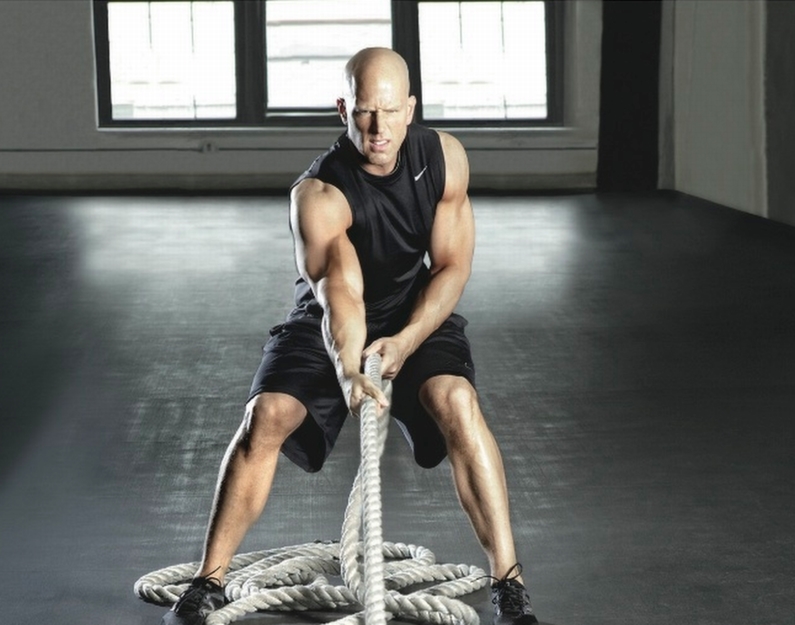Most guys are in the gym to change their physique. If you could boil it down to one mistake, where would you say the majority of guys are going wrong?
There are A LOT of mistakes that can be and are being made in just about every gym I walk into. If I had to pick “the biggest” it would probably have to be exercise selection. I’m still shocked that, in this day and age, with so much good information available, there are a lot of guys who walk into the gym and their “A1” movement is machine shrugs. I’m far from being an ‘anti-isolation’ guy but if you aren’t using the big, basic compound movements such as squats, presses, pull ups, deadlifts and lunges, your physique probably isn’t going to be where you want it.
Using slow, controlled reps seems to be extremely popular in muscle-building routines. Is that the most effective way to build muscle?
Slow, controlled eccentrics are certainly a great way to cause muscle damage which is needed for muscle growth. By ‘eccentric’ I am referring to the lowering phase of any lift. The same has not been proven for the concentric (lifting phase) of any movement, so I’m not a believer in ‘slow burn’ type programs where you lift and lower the bar as if you were trying to move in Matrix-like slo-motion. So, yes, lowering in a controlled manner and managing the tempo of the lift is a strategy I use often when building mass, but you have to do it in a smart way that still allows you to manage relatively heavy loads, maintain the integrity of the movement pattern and, hopefully, keep you somewhat athletic.
The fitness industry has seen a drastic turn from isolation exercises in favor of full-body moves. Are isolation exercises still necessary?
As I mentioned earlier, I do think that almost all trainees would benefit from making compound movements the foundation of their programs. However, there is certainly room for isolation movements such as biceps curls, calf raises and pressdowns — particularly if building mass is your goal. Contrary to what some may say, your not going to get big arms simply by squatting. However squatting can be a beneficial part of your arms building program. In fact in my new “2 Tickets To The Gun Show” 4-week arm specialization program, I start off each workout with a major compound movement — even though the goal of the program is to build massive, ripped, freaky arms. And judging by the results people have gotten, that forumla seems to work.
How many days should the beginner lifter be looking to hit the gym for some muscle-building results?
Being a beginner can really be tough. You get very sore. You don’t feel really comfortable in the gym. You’re not sure what to do. The good news is that, as a beginner, your body is primed to make gains relatively quickly — usually faster than they ever will again. And seeing these quick gains can be exciting and drive you to go back to the gym day after day. But recovery is just as important for beginners as it is for experience trainees (though the amount of recovery will certainly be different). I think the ‘sweet spot’ is still 3 days per week. This will give the beginner enough of a stimulus to make gains and get more comfortable with basic movement patterns while still giving them enough time to recover from the crazy DOMS they tend to get when first starting out.
Nutrition obviously plays a huge role in adding muscle. What are some easy tips guys can use to fuel their body properly?
Pay attention to your nutrition in the workout window (the timeframe just before, during and directly after training). Try to eat 90 minutes prior to training, take a post workout shake of protein and carbs immediately upon the completion of the last rep of the session and have a whole food meal an hour later. The time around workouts is the most critical time to fuel up as well as start the muscle repair process. If you do not take this opportunity to optimize your nutrition, you are not maximizing your gains. Simple as that.
Most guys tend to lay off the leg days in favor of more upper body training. Mistake?
Huge mistake. And a mistake I made early on in my training. I thought running on the treadmill was training legs. Leg training does several things: It creates a more optimal hormonal environment to build mass overall. It makes you more powerful and athletic. And even if your goal is only to build your upper body, it gives you a base upon which to build that upper body mass. You never going to be able to build a big house on a foundation of toothpicks.
Time is obviously a huge factor for many people in the gym. How long should they set aside for a good workout including warm-up and cool-down.
I think 50 minutes is the ideal training time. However there are days when training will take 75 minutes and there are days when you can crush it in 15. But if building muscle is the goal, 50 minutes is about right. Think of it this way, there are 168 hours in a week, you should be able to find a way to dedicate 3 to 4 hours of them to training.
Be sure to pick up a copy of Dan’s new e-book on building muscle Two Tickets to the Gun Show!
